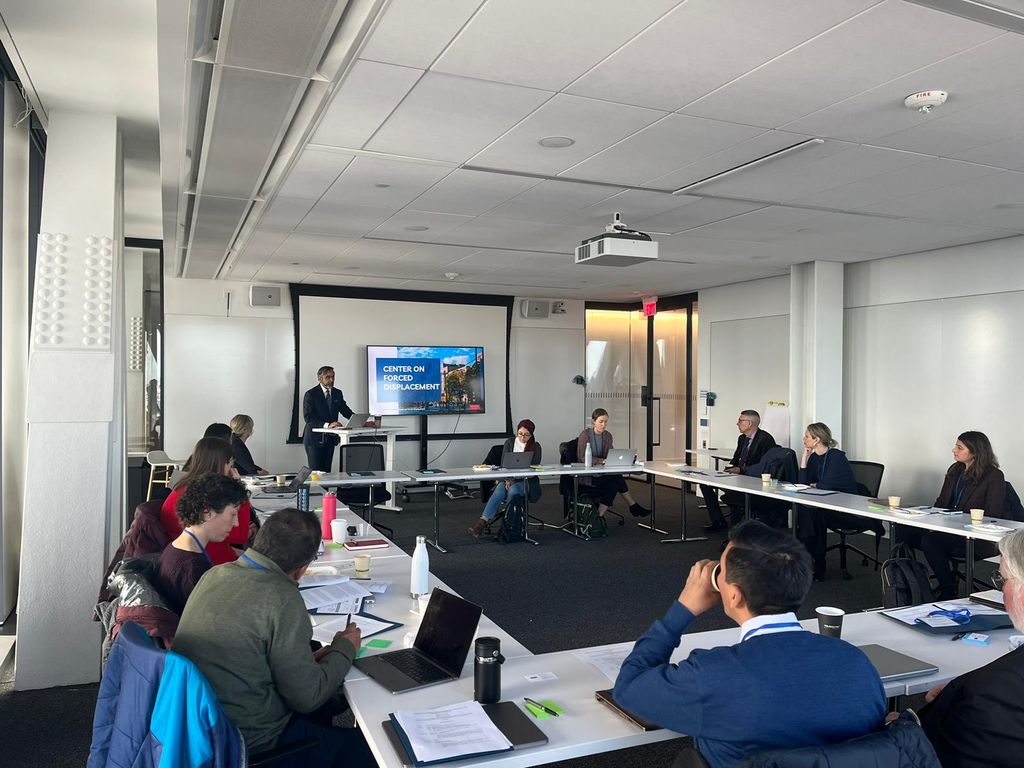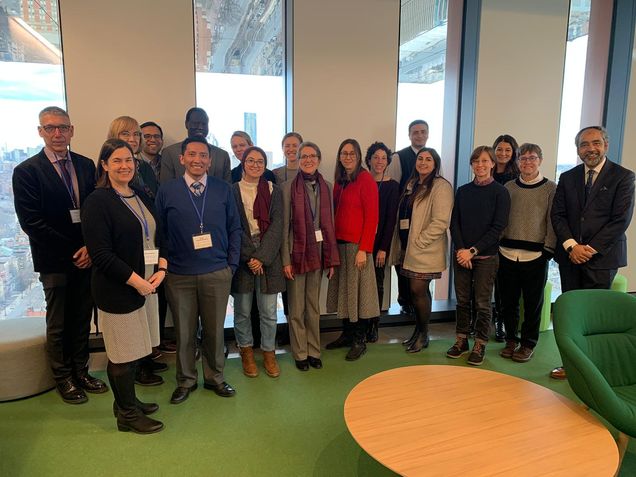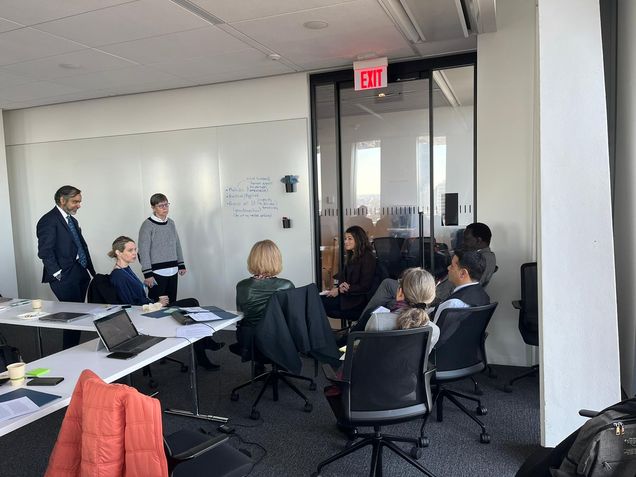STEM Education and Forced Displacement – Workshop Reflections
 On March 9-10, 2023, the Center on Forced Displacement (CFD) at Boston University and the Committee on Human Rights (CHR) of the U.S. National Academies of Sciences, Engineering, and Medicine hosted a workshop about STEM education and forced displacement. The workshop brought together experts in the fields of engineering, human rights, forced displacement, and pedagogy to develop a course that would prepare STEM students to help address challenges associated with forced displacement. Since last fall, we have worked to review and consolidate the relevant literature to understand what’s missing from existing courses and think about the questions and concepts that should guide the workshop’s conversations. Being part of the planning team gave me the opportunity to learn about the process of developing a workshop and engage with experts from a range of fields, seeing our conceptions of the workshop on paper – from bios to spreadsheets to email exchanges – come to fruition in a room filled with vibrant conversations, colleagues who traveled just a few hours and others across the globe to be there, brought together by a shared desire contribute to this pressing issue.
On March 9-10, 2023, the Center on Forced Displacement (CFD) at Boston University and the Committee on Human Rights (CHR) of the U.S. National Academies of Sciences, Engineering, and Medicine hosted a workshop about STEM education and forced displacement. The workshop brought together experts in the fields of engineering, human rights, forced displacement, and pedagogy to develop a course that would prepare STEM students to help address challenges associated with forced displacement. Since last fall, we have worked to review and consolidate the relevant literature to understand what’s missing from existing courses and think about the questions and concepts that should guide the workshop’s conversations. Being part of the planning team gave me the opportunity to learn about the process of developing a workshop and engage with experts from a range of fields, seeing our conceptions of the workshop on paper – from bios to spreadsheets to email exchanges – come to fruition in a room filled with vibrant conversations, colleagues who traveled just a few hours and others across the globe to be there, brought together by a shared desire contribute to this pressing issue.
The fields of engineering, basic, and applied sciences are often absent in conversations about teaching about forced displacement. While models do exist for integrating forced displacement into STEM education, these efforts rarely provide students the opportunity to approach the issue holistically. For example, design-based courses might take students through the engineering design process and allow them to apply technical skills to develop interventions to be used in a refugee camp. But these courses tend to focus only on a select few issues, like those related to water, sanitation, and hygiene, and often do so using siloed approaches. These models often also consider narrow definitions of displacement without fully considering the limitations of existing frameworks and categories, which might exclude internally displaced and stateless people, the fact that living conditions range vastly beyond typical refugee camps, that forced displacement is a process and not a single event, and that challenges exist throughout this entire journey and not only at a destination. Students are often drawn to the potential to engage with complex societal issues like this one, but approaching the topic this way can also foster mindsets that engineering always has the answers, always contributing solutions rather than potentially creating or exacerbating challenges. Students might begin to believe complex, multi-faceted issues associated with forced displacement can be swiftly resolved with the right engineering skills or in the words of one workshop participant, whenever faced with even the most complex challenges, respond by thinking, “we can build an app for that.”
The workshop was premised on the idea that forced displacement should be incorporated into STEM education as more than just an afterthought, recognizing that any examination of the topic requires holistic, interdisciplinary thinking and an understanding that any single discipline will never have all of the answers. For example, in order to think about the types of interventions appropriate for a refugee camp, students need to first understand the deep-rooted social and political factors that may have turned what was once a temporary arrangement into a protracted situation spanning generations. Students cannot think about introducing digital technologies in an informal settlement without first understanding that particular attention must be paid to preserving the rights and privacy of those fleeing hostile governments, and their expected hesitance to accept unfamiliar technologies as a result. The group therefore agreed early on the course would need to be interdisciplinary.
In many ways, the workshop mirrored the dynamic we hope to achieve in bringing together an interdisciplinary group of students to the proposed course. While often fostering rich discussions, communicating across disciplines can also bring frustrations. Some members of the group might have become frustrated by the engineers’ seemingly rigid, solution-driven thinking and reflexive desire to assign solutions to problems, rather than letting prolonged, branching discussions with less concrete objectives take their course. Those coming from engineering backgrounds could become frustrated by extended discussions of abstract, theoretical frameworks filled with human rights jargon, which typically wouldn’t find their place in an engineering curriculum in the same terms. Despite this, we found that the group wanted to see many of the same things in this course and hoped students would take away many of the same concepts, from specific skills to broader understandings of their potential to contribute to addressing complex issues like forced displacement using their engineering skills. The two days’ discussions were rich and nuanced, and despite disagreements about what it means to be a “climate refugee,” whether such a term is even warranted, or why it was even worth having such a debate at all, and moments of disagreement about the types of materials essential to the course, with many participants bringing in prior experience developing related programs, all looking very different, a relatively clear course concept emerged by Friday morning.
Students taking an interdisciplinary course will likely face similar frustrations. But as the workshop demonstrated, the initial discomfort and frustration often yields nuanced, meaningful results. Among the main takeaways from our discussions was the idea that both instructors and students in such a course would need to learn to find comfort in uncertainty and recognize that neither will always have the answers. In an interdisciplinary course covering a topic many STEM students haven’t been exposed to, students will likely come into the course with a number of misconceptions related to forced displacement. The group spent time discussing many of the misconceptions they expect to or have seen among students – including the idea that all refugees live in camps and all camps look the same, that all data and data representations in this area are completely objective, limited understandings of the role of the UN and its biases – and the need to address and identify these early on in the course through a pre-course assessment, to ensure new concepts are not being built upon or entangled with inaccurate assumptions.
Beyond the tangible outputs of the workshop, this brief gathering also revealed the value of bringing together and fostering communities on the basis of shared interdisciplinary interests, where perspectives and ideas can be exchanged in ways that often can’t happen in siloed departments. Faculty who are interested in integrating concepts like forced displacement into their teaching and research are often faced with pressures to focus on more important outputs or stay within their field or prove the technical rigor of interdisciplinary engineering-based courses, which might force instructors to overload if they wish to pursue such courses out of passion. As a recent graduate and a student who shared an interest in merging my interests this way, I experienced similar feelings – faced with messaging that told me that pursuing interdisciplinary work would make me seem less focused or undermine the perceived rigor of my technical background, that I needed to choose between pursuing an area out of passion and finding financially feasible career options, suggestions that not every interest had to become a career and that an interest in forced displacement could just remain a passion on the side.
As someone interested in pursuing graduate studies, I’ve found similar frustrations in the limitations of the types of programs offered. Looking to pursue questions related to forced displacement, I could consider applying to a number of programs that dealt with independent issues in these areas, such as in global health, but none felt like they would allow me to fully integrate my interests and approach the issue from the interdisciplinary lens it required. In speaking to one of the workshop participants about how she arrived at her research interests, she explained that she always knew she wanted to end up where she did – integrating human rights and engineering – before she began graduate school, but couldn’t find a program that did this. So, she decided she’d pivot to an only slightly related topic for her graduate studies and plan to return to her true interests once she had a faculty position and the freedom to pursue questions that interested her beyond traditional disciplinary boundaries. If forced displacement were truly integrated into STEM curricula, students wouldn’t have to put their true interests on hold or settle for programs only tangentially related to their intellectual interests or be led to believe a topic like forced displacement would always just have to remain a hobby or passion, secondary to more rigorous academic areas. Taking a course like this one as an undergraduate would have allowed me to understand the potential to integrate my interests in this area, beyond the typical solutions-based frameworks that were presented to me. While a single course came out of this workshop, we hope it will be the start of a broader conversation which will pave the way for standard STEM curricula more broadly to foster interdisciplinary thinking, encourage students to grapple with complex issues and their ethical complexities and inspire them to use their technical background to make a positive impact.